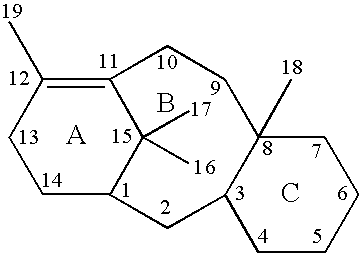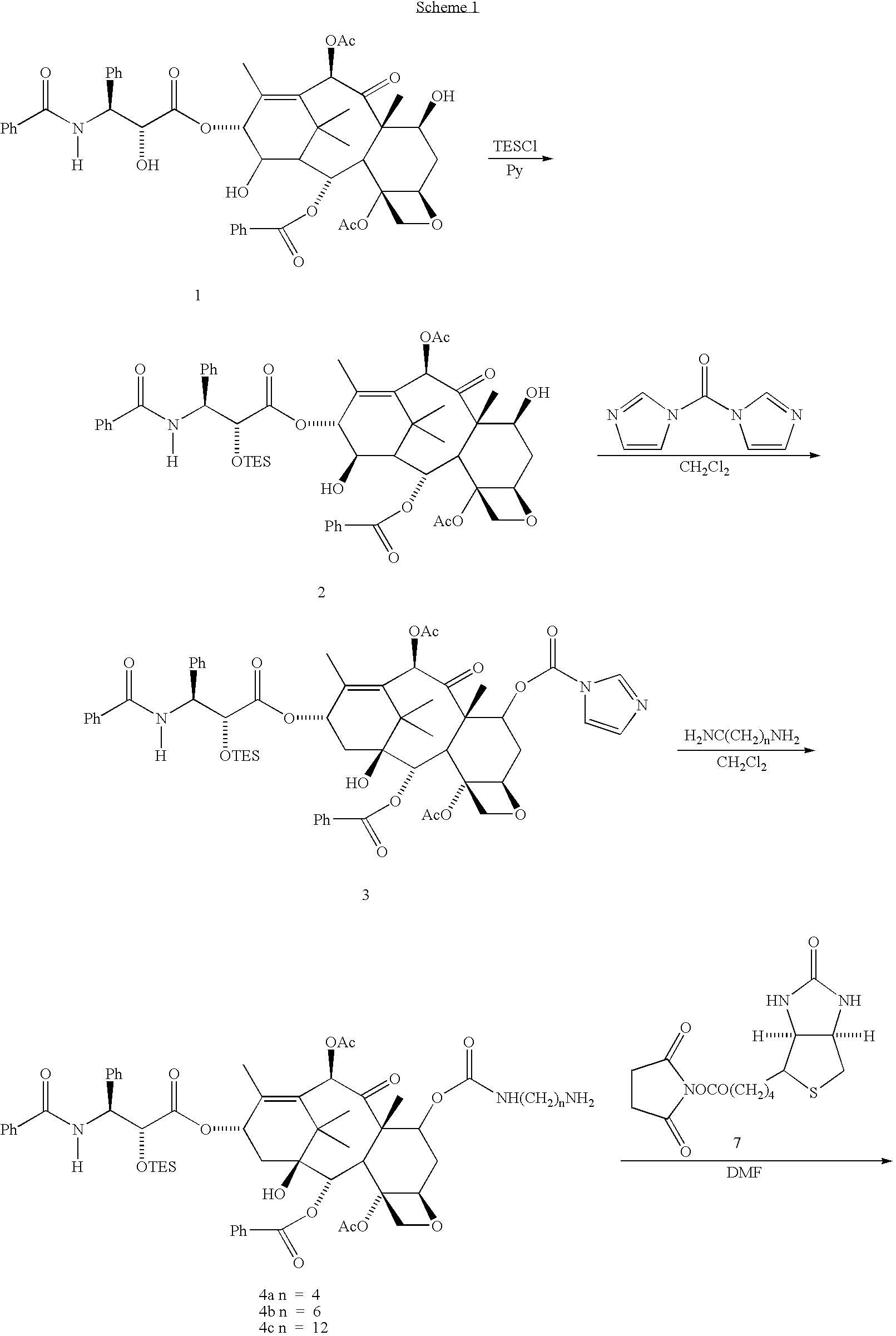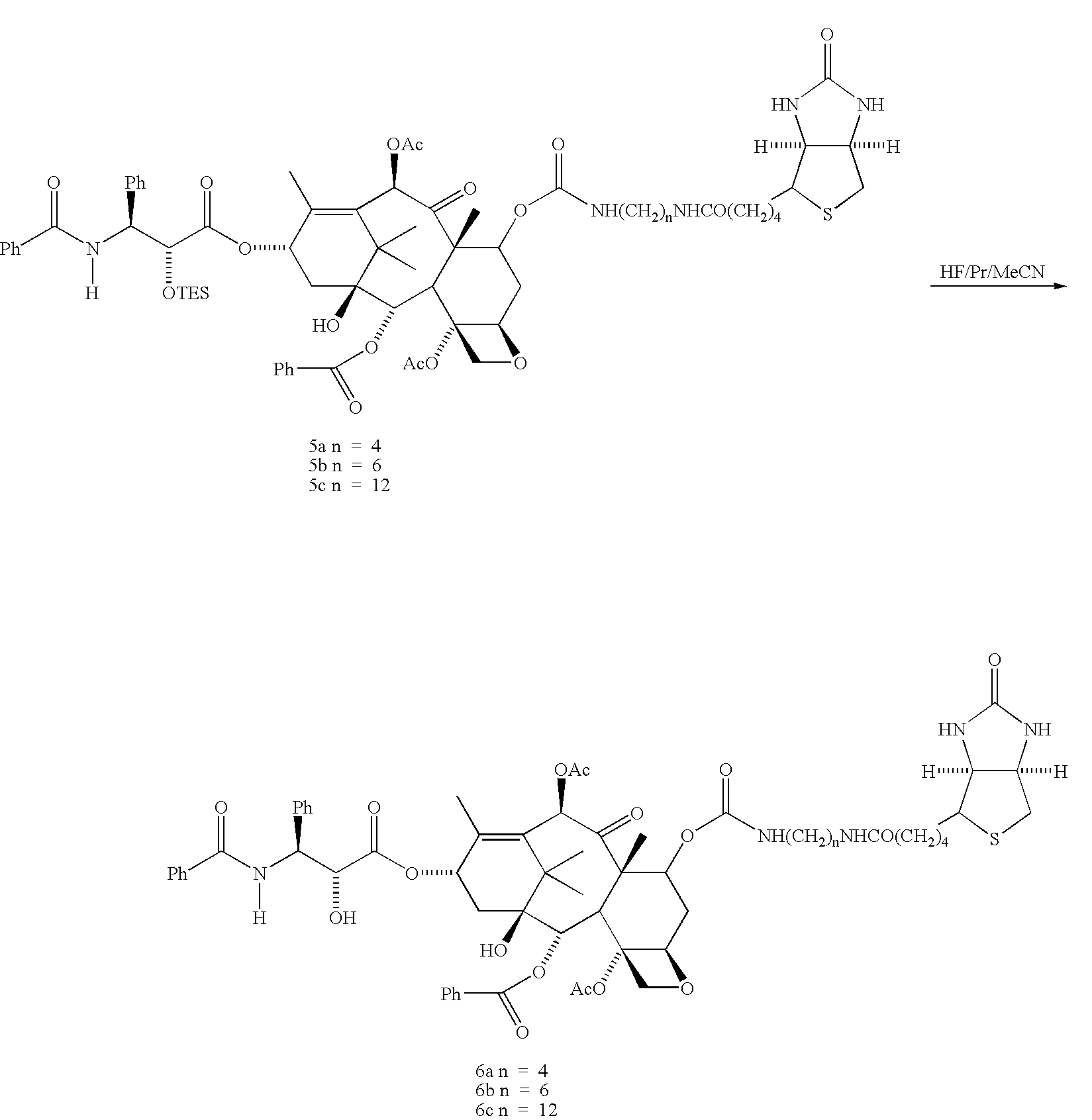Identification of molecular targets
- Summary
- Abstract
- Description
- Claims
- Application Information
AI Technical Summary
Benefits of technology
Problems solved by technology
Method used
Image
Examples
example 1
Identification of Taxol Binding Peptides
[0070]Taxol is an anti-cancer drug with proven efficacy against a wide variety of malignancies, with those of most clinical interest being human breast and ovarian carcinomas (Rowinsky and Donehower, 1991). Its only known molecular target is tubulin which it induces to polymerize, disrupting the dynamic instability of microtubules in the mitotic apparatus and halting mitosis at the metaphase / anaphase transition (Jordan et al., 1993). A wide variety of other responses to taxol have been reported, including the induction of programmed cell death or apoptosis, an increased level of a number of intracellular messengers and growth factors including p53 (Roth, W. 1998), and the phosphorylation and subsequent inactivation of the anti-apoptotic protein Bcl-2 (Haldar et al., 1995; 1996). These activities are thought to be indirectly induced by the action of taxol on microtubules.
[0071]In an attempt to identify potential binding sites for taxol on β-tub...
example 2
Preparation of Biotinylated Taxol
[0083]The taxol derivatives, 7-biotinamidocarbamate 6 a-c, were synthesized as shown in Scheme I. Reaction of taxol and TESCI in pyridine at 0° C. gave 2′-TES-taxol 2 in 84% yield. Compound 2 reacted with carbonyldimidazole in CH22Cl2 at room temperature to yield the 2′-TES-7-imidazolidetaxol 3 in 94% yield. Treatment of 3 with a large excess of diamines H2N(CH2)nNH2 (50 equiv., n-4,6,12) in CH2Cl2 at room temperature afforded the aminocarbonates 4 (a, n−4; b, n=12). Without further purification, 4 a-c were treated with biotin N-hydroxylsuccinimide ester 7 at room temperature in DMF to give 2‘-TES’7-biotinamido-carbamate 5a-c. Removal of the 2′-TES groups from 5a-c with HF / Py / MeCN (1:10:10 v / v / v) at room temperature afforded the desired 7-biotinamidocarbamated 6a-c after chromatography.
examples
[0084]2′-TES-taxol 2. To a solution of taxol (247 mg, 0.289 mmol) in pyridine (2.9 mL) at 0° C. was added 0.87 mL of a 1.0 M solution of TESCI in pyridine (0.87 mmol). The mixture was stirred at 0° C. for 7 h, then at room temperature for 8 h, and diluted with EtOAc. The resulting mixture was washed with saturated aqueous NaHCO3, water, 10% CuSO4, water, and brine, dried over Na2SO4. The solvent was removed in vacuo to yield a light yellow oil (345 mg). Chromatography (3:2 v / v hexane / EtOAc) gave 2 as a white solid after removal of solvent (236 mg, 84%).
[0085]2′-TES-7-imidazolidetaxol 3. To a solution of 2′-TES-taxol (2, 251 mg, 0.259 mmol) in CH2Cl2 (10 mL) was added carbonyldiimidazole (422 mg, 2.60 mmol). The mixture was stirred at room temperature for 19 h, diluted with EtOAc (50 mL), washed with saturated aqueous NaHCO3, water, brine, dried over Na2SO4. The solvent was removed in vacuo to yield 3 as a white solid (249 mg, 0.234 mmol, 91%).
[0086]Aminocarbonate 4a. To a solution o...
PUM
| Property | Measurement | Unit |
|---|---|---|
| Mass | aaaaa | aaaaa |
| Mass | aaaaa | aaaaa |
| Affinity | aaaaa | aaaaa |
Abstract
Description
Claims
Application Information
 Login to View More
Login to View More - R&D
- Intellectual Property
- Life Sciences
- Materials
- Tech Scout
- Unparalleled Data Quality
- Higher Quality Content
- 60% Fewer Hallucinations
Browse by: Latest US Patents, China's latest patents, Technical Efficacy Thesaurus, Application Domain, Technology Topic, Popular Technical Reports.
© 2025 PatSnap. All rights reserved.Legal|Privacy policy|Modern Slavery Act Transparency Statement|Sitemap|About US| Contact US: help@patsnap.com



